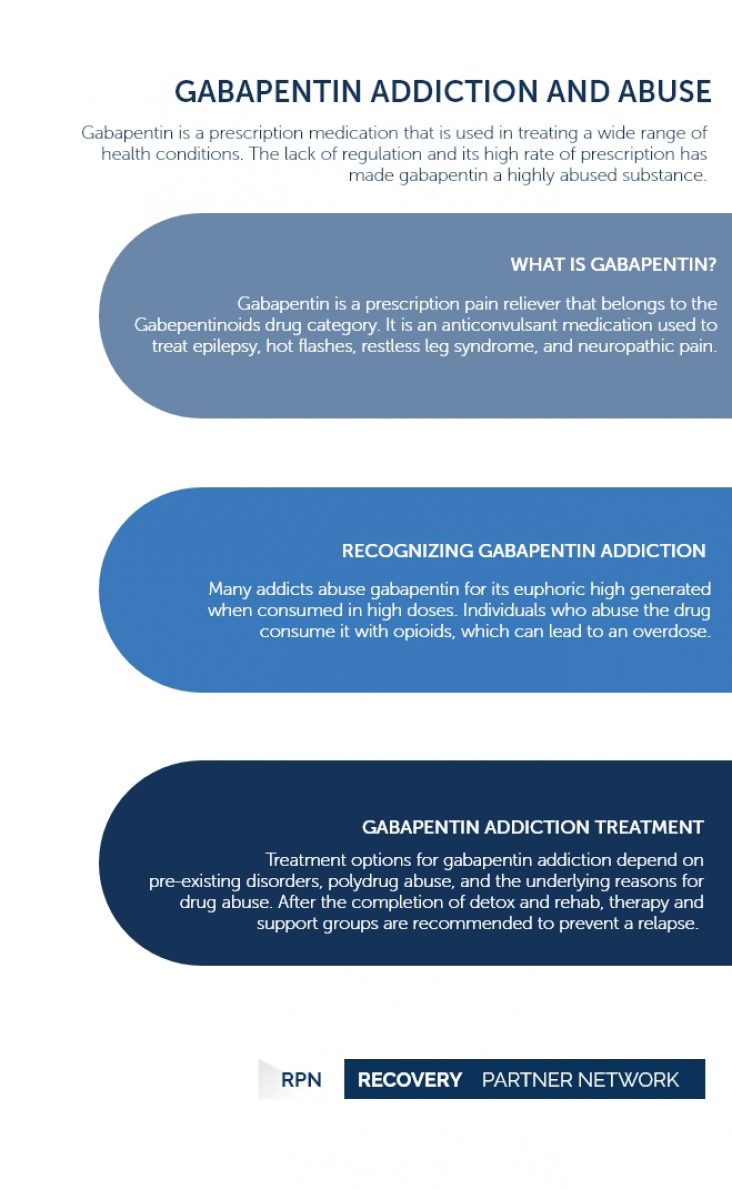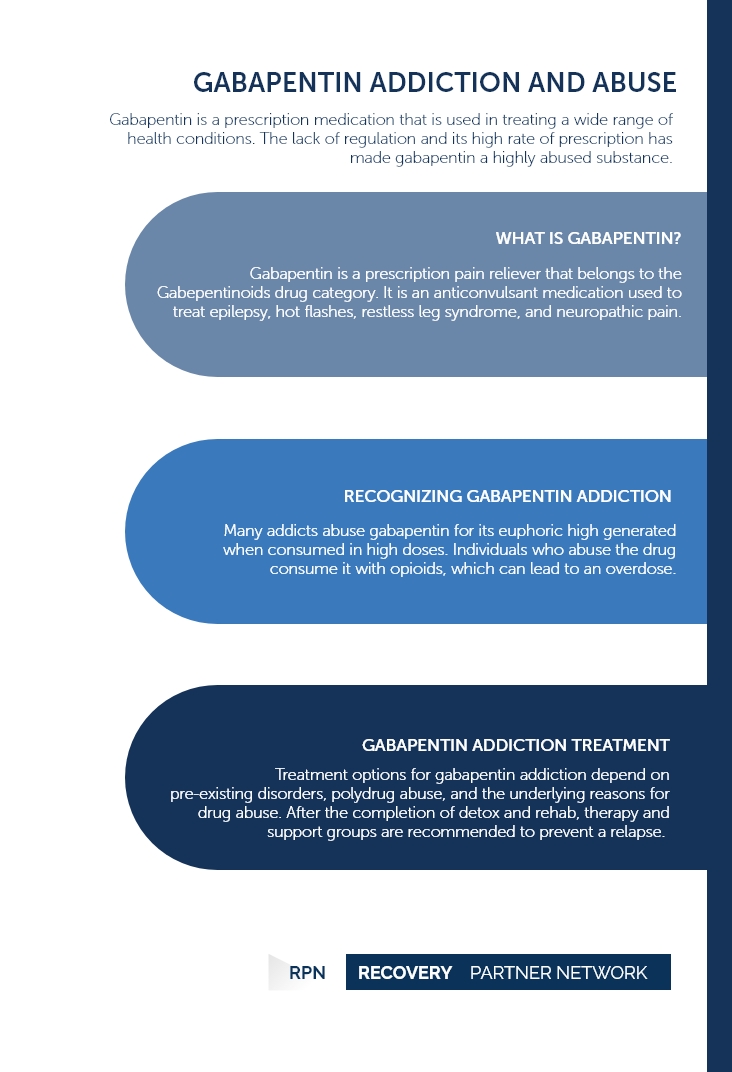Gabapentin is a prescription medication that is used in treating a wide range of health conditions. The lack of regulation and its high rate of prescription has made gabapentin a highly abused substance.
Gabapentin Addiction and Abuse
Illicit drugs
- Ayahuasca addiction – Abuse
- Baclofen addiction
- Black tar heroin addiction
- Cannabis addiction
- Cocaine dependence
- Crack cocaine addiction
- DMT addiction abuse treatment
- Does Marijuana Kill Brain Cells?
- Ecstasy addiction
- Gabapentin addiction
- gamma-Hydroxybutyric acid addiction
- Hallucinogen
- Heroin addiction
- Illicit drug addiction
- Inhalant addiction
- Cocaine
- Ketamine addiction
- Lysergic acid diethylamide addiction
- Mescaline addiction
- Methamphetamine addiction
- Meth Labs: Cooking up Addiction
- Meth Mouth
- Microdosing
- Phencyclidine addiction
- Psilocybin mushroom addiction
- Sage of the diviners – Addiction
- Shooting Heroin
- Shooting Methamphetamine
- Smoking Cannabis
- Speedball
- Synthetic cannabinoids
Gabapentin addiction | Table of Contents
What is Gabapentin?
Gabapentin is a prescription pain reliever that belongs to the Gabepentinoids drug category. This drug is also known by its brand names Neurontin and Gralise. Gabapentin is an anticonvulsant medication that is generally used to treat conditions like epilepsy, hot flashes, restless leg syndrome, and neuropathic pain.
Gabapentin’s capacity to treat multiple health conditions has made this drug the most prescribed medication in the US. GoodRx reported in May of 2019 that it was the fifth most medically prescribed drug in the country. Gabapentin is manufactured in the form of capsules, tablets, and oral solutions. This medication has not been inducted into the Controlled Substance Act and, consequently, has increased its chances of being abused. Street names for gabapentin are Gabbies or Johnnies.
FAQ
Gabapentin is used in combination with other treatments to treat and prevent seizures. It is often used to help alleviate nerve pain following shingles (an unpleasant rash caused by herpes zoster infection). Gabapentin is used as an anticonvulsant or antiepileptic drug.
Gabapentin is reasonably safe if taken as prescribed. Nevertheless, some individuals may experience side effects such as delusions, blurred vision, lack or loss of strength, dementia, trembling, shaking, swelling, lower back pain, and hoarseness.
Gabapentin Effects, Abuse, and Addiction
Gabapentin has an identical chemical structure to that of gamma-Aminobutyric acid (GABA). GABA is a naturally occurring chemical found in the brain. It functions by decreasing the actions of neurons it binds itself to. This medication can induce feelings of relaxation and calmness, and a feeling of euphoria, similar to that of marijuana when abused. This drug also works by altering an individual’s calcium channels to reduce seizures.
Gabapentin is medically prescribed to treat conditions like:
- Post-herpetic neuralgia
- Seizures caused by cocaine and alcohol withdrawal
- Restless leg syndrome
- Fibromyalgia
- Poor sleep
- Anxiety
Apart from the health conditions mentioned above, gabapentin was also widely marketed to treat off-label health conditions such as bipolar disorder, attention deficit disorder, and migraine. Although this medication was considered to hold a low abuse potential, gabapentin’s high prescription rate, lack of regulations, and its ability to be consumed with other drugs created a widespread health risk and addiction concern.
In most cases, gabapentin abuse is usually associated with individuals with a history of drug addiction. Individuals consuming the drug without a medical prescription is a growing concern in many areas. Though this drug is used as a less addictive alternative solution to opioids, gabapentin addiction and abuse still occur in many users. Regular and high amounts of gabapentin consumption can lead to physical and psychological dependence on the drug.
Mentioned below are some of the effects of excessive gabapentin use:
- Drowsiness
- Lack of co-ordination
- Tremors
- Dizziness
- Depression
- Suicidal thoughts/behaviors
- Changes in mood
- Elevate blood pressure
- Forgetfulness
- Anxiety
- Difficulty speaking
- Inability to feel pleasure
- Chest pain
- Appetite changes
- Fever
- Mood swings
- Amnesia
- Agitation
- Aggressive and violent behavior
FAQ
- What are the side effects of gabapentin?
- What is the most common side effect of gabapentin?
- Does gabapentin help you sleep?
Gabapentin’s more common side effects include abnormal eye movements (which are continuous, uncontrolled, back-and-forth, or rolling movement in the eyes), clumsiness, constipation, diarrhea, trouble speaking, sleepiness, fatigue, dried mouth, and nausea.
Drowsiness and dizziness are common side effects of gabapentin. Gaining weight and lack of coordination are other potential side effects.
Gabapentin is an effective treatment for insomnia.
Recognizing Gabapentin Addiction
Many addicts abuse gabapentin for its euphoric high generated during the consumption of high doses (800 mg or more), and its ability to not be detected during drug screening. Individuals who consume gabapentin generally consume the drug with opioids to generate the desired high.
Mentioned below are some of the signs of gabapentin addiction:
- Lying about symptoms to doctors.
- Visiting multiple doctors to acquire extra dosage.
- Switching doctors after the initial doctor refuses to continue prescribing the medication.
- Changes in behavior and personality.
- Lack of personal hygiene.
- Constantly preoccupied with drug use.
- Distress at the thought of the drug being unavailable.
- Refusing to quit despite social, financial, or legal consequences.
- Multiple failed attempts to quit the drug.
- Experiencing cravings.
- Requiring higher doses to achieve the desired effect.
FAQ
- Is gabapentin considered a painkiller?
- How long does it take for gabapentin to work?
- Can you drink alcohol with gabapentin?
- Who should not take gabapentin?
- What drugs should you not take with gabapentin?
- What happens if gabapentin is combined with opioids?
Gabapentin, commonly known as Neurontin, is a prescribed painkiller of its own drug class, Gabapentinoids.
The pain usually begins to subside in about one to two weeks after taking gabapentin, but it may take more time in some individuals. However, some people feel the impact right away.
There is no risk of taking alcohol with gabapentin. However, it may make you feel drowsy or fatigued.
It is not advisable to use gabapentin if an individual is allergic to it or has health conditions such as skeletal muscular disorder, depression, decreased lung function, chronic kidney disease, and myasthenia gravis.
Gabapentin administered in combination with opioids raises the chances of respiratory depression and death even when used for valid reasons.
Gabapentin Overdose
Gabapentin overdose is very similar to a Vicodin or heroin overdose. However, unlike other opioid overdose treatments, gabapentin does not have an antinode that can instantly block the substance from affecting the brain during an overdose. The chances of a potential overdose are highly increased when gabapentin is combined with other substances, such as opioids and alcohol. Gabapentin’s use as a cutting agent in street heroin also increases its potential to cause dangerous health effects, addiction, and fatal overdose.
Given below are common signs of gabapentin overdose:
- Diarrhea
- Ptosis (drooping upper eyelid)
- Hypoactivity
- Ataxia (decreased muscle co-ordination)
- Labored breathing
- Excitation
- Slurred speech
- Drowsiness
- Lethargy
- Double vision
- Marked sedation
FAQ
Regardless of whether someone consumed too much gabapentin intentionally or accidentally, they can encounter blurry vision, difficulty speaking, sleepiness or diarrhea.
Gabapentin is produced in 100, 300, 400, 600, and 800 mg tablets. The recommended dose varies between 1800 to 5400 mg a day. However, the dosage largely depends on how well the medication works for you as well as your level of tolerance to the medication.
Gabapentin Detoxification and Withdrawal
Stopping the consumption of gabapentin cold turkey is considered to be dangerous as it can generate severe withdrawal symptoms. Gabapentin withdrawal symptoms generally appear within 24 to 48 hours after the last dose. However, some may even experience symptoms within a week after their last dose.
Gabapentin withdrawal symptoms may include:
- Agitation
- Tremors
- Increase in heart rate
- Gastrointestinal symptoms
- Profuse sweating
- Insomnia
Abruptly quitting drug consumption can also increase the chances of an individual having seizures. This condition can lead to personal injury or the development of medical issues and potentially fatal emergencies. Therefore, quitting the consumption of gabapentin should be done at a rehab facility or under the supervision and guidance of a medical professional during medical detox.
There are no clinical protocols for the treatment of gabapentin withdrawal. Doctors will have to closely monitor their patients during detox and treat symptoms when required. However, the general consensus among medical professionals during gabapentin detox is the use of tapering down method as it can help avoid serious withdrawal symptoms. Although patients are allowed to taper their dosage at home, it is highly advisable to carry out this procedure under the guidance of a doctor. If you have taken large doses of prescription gabapentin, you can contact your doctor before tapering down or decide to quit taking the drug. Your doctor will address the dangers and advantages of avoiding gabapentin. During this process, doctors may also recommend alternating to another medication, depending on the severity of your addiction and features of any co-occurring mental health disorders that you may have.
Gabapentin Addiction Treatment
Long-term recovery options for gabapentin addiction would depend on the existence of pre-existing disorders, polydrug abuse, and the underlying reasons for drug abuse. After the completion of detoxification, patients are recommended to seek treatment at an inpatient or outpatient treatment center to address the psychological aspect of addiction. These treatment centers provide patients with services such as councelling, therapy, and support groups.
Comprehensive recovery services usually integrate a number of strategies to help patients understand their addiction and acknowledge and address the cause. Individual and group counseling sessions help patients recognize destructive behavioral habits that led them towards addiction. These programs will greatly benefit patients as they are taught relapse prevention techniques and positive and healthy methods to deal with triggers and cravings.
In addition, the introduction to support groups will provide patients a safe space and a sense of community among their peers as they hold each other accountable for their actions. This has been proven to be a successful method to prevent relapses in the long run.
Recovery Partner Network
We aim to educate and empower. If you feel our library of resources does not cover your specific need, reach out to us, and we would be happy to help.
STATISTICS
© Copyright 2025


